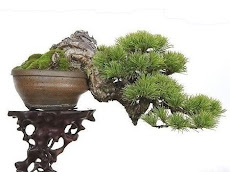Story By: Ruth Morgan
Many people admire flowering bonsai. The combination of the brilliant colours of the flowers and the miniature size of the tree create a spectacular flowering bonsai.
There are lots of species of flowering bonsai. They include Satsuki Azalea, Cotoneaster, Winter Jasmine, Crab Apple, Flowering Cherry, White and Red Hawthorn, Japanese Flowering Apricot, Wisteria, Serissa, Firethorn, Deciduous Holly, Quince and Pomegranate. Some are suitable for the outdoors whilst others can be kept indoors. They all produce different displays and are very much valued as bonsai. Details about 3 of the most popular are given below.
1. Satsuki Azalea (Rhododendron indium) produces magnificent displays of flowers in late spring / early summer. This explains the origin of the satsuki name (meaning fifth moon in Japanese - corresponding to the time of flowering in June). It is possible for the same tree to produce flowers with different colours and different markings.
These colourful azaleas have been grown by the Japanese for over 300 years. A tip for buying Satsuki Azaleas is to do so during the flowering season when you can see the splendour of the colours. Azaleas are best kept in semi-shade outdoors. During the winter they should be protected from wind and frost. It is important to use lime-free soil and to remove dead flowers quickly.
2. Another favourite flowering bonsai is Crab Apple (Malus species). Many varieties are available which produce wonderful fragrant flowers of different colours in spring. There is a range of colours - from cerise to pink to cream to white. The small autumnal fruits also come in different colours. Prolific flowering is encouraged by pruning in late summer. Crab Apples should be repotted every year in early spring before the start of growth.
Common varieties include Halls Crab Apple, Common Crab Apple and Nagasaki Crab Apple. Crab Apples should be kept in full sun. Frost is not a problem, unless the bonsai are small. They need plenty of water, especially when the fruit is being formed. Because of this a deeper than normal pot should be used for Crab Apple. The informal style is popular - with single and multi-trunk forms.
3. The third flowering bonsai is pomegranate (Punica granatum). It is native to the Mediterranean and China. The geographical spread of this tree was greatly helped by the Romans! It is an ideal bonsai as it has a twisted trunk, gnarled bark, colourful funnel shaped flowers and yellow / red fruits. In addition, the leaves turn yellow in autumn. This results in a wonderful bonsai tree, often seen as an informal upright style.
It should be placed in full sun during the growing season - this can be either indoors or outdoors. But in very hot weather trees that are kept indoors should have their roots protected from the sun. If winter temperatures are kept above 17 degrees Centigrade (63 degrees Fahrenheit) the pomegranate will remain evergreen. It should not be exposed to temperatures below 5 degrees Centigrade (41 degrees Fahrenheit) but brought indoors to a well lit cool position.
All of these trees are relatively easy to grow and are therefore suitable for newcomers to bonsai. Experiment and enjoy!
About the Author
Ruth Morgan is the author of Beautiful Bonsai Secrets - a step-by-step guide to growing and developing beautiful bonsai trees. To claim more free information about bonsai go to http://beautifulbonsaisecrets.com today.
Article Directory Source: http://www.articlerich.com/profile/Ruth-Morgan/73555
skip to main |
skip to sidebar
Guide and Tips on Bonsai growing and caring.Cultivation, pruning, shaping, an Art and Hobby for you to practice






